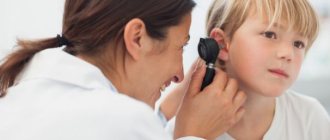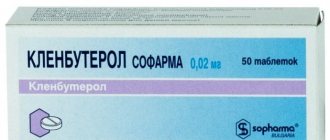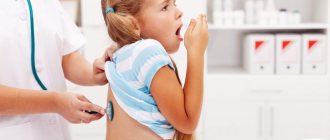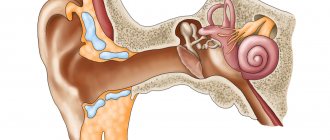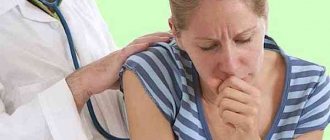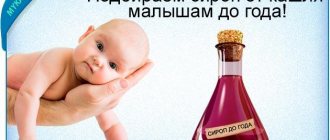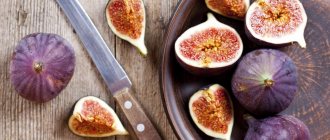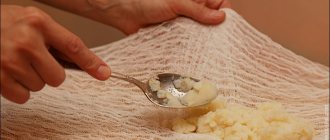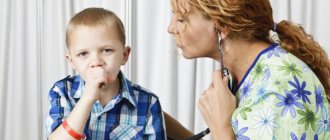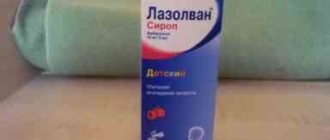- Avoid massage for the first few days until expectoration appears.
Regularity is the key to a quick recovery. The procedure is performed twice a day until he begins to actively discharge sputum. Duration – 10–15 minutes, course – five days.
We recommend watching a video on how to perform a massage to remove sputum in children. And also how to calm a night cough, long-term dry, wet and lingering.
Indications
Cough massage is recommended for excessive accumulation of mucus in the respiratory tract, which is difficult to separate. This situation is possible if the child:
- Cold.
- Bronchitis.
- Bronchial asthma.
- Pneumonia.
- Emphysema.
- Pneumosclerosis.
Benefit
Cough massage is a good alternative to using medications. This procedure can be carried out from birth, and parents can learn how to perform it without involving specialists.
In addition to stimulating mucus discharge, the following massage:
- Stimulates blood and lymph flow.
- Strengthens muscle fibers involved in breathing.
- Increases rib mobility.
- Stabilizes respiratory function.
- Enhances the effect of using medications.
Contraindications
Cough massage is not recommended if:
- The child's body temperature is elevated.
- The baby has just eaten.
- A cold or other respiratory disease has just begun (massage is indicated only from the 4-5th day of the disease, when the acute stage has passed).
- The baby feels discomfort in the tummy position.
- Complications of the underlying disease appeared.
- The baby has skin diseases.
- The baby's body weight is too low.
Contraindications for massage
Before starting cough treatment with massage sessions, it is important to consider possible contraindications. For example, cryomassage is performed only during the recovery stage. Exposure to cold during the period of active disease is contraindicated.
Massaging a cough is strictly prohibited in the following cases:
If you have pulmonary tuberculosis, massage is prohibited
- with an increase in body temperature;
- during periods of exacerbation of chronic diseases;
- in the presence of oncological formations in any organ;
- for heart defects;
- for hypertension;
- with greatly reduced blood pressure;
- for skin diseases;
- for tuberculosis;
- if you are allergic to honey or other medicinal ingredients;
- if there are warts, papillomas or moles in the massage area;
- against the background of severe liver and kidney dysfunction.
When the problems go away, the technique can be successfully used, since the method is an excellent remedy for coughing.
If you take into account all the indications and contraindications, the treatment will bring many benefits. Before starting the course, it is advisable to consult with your doctor to select the most appropriate technique for performing the procedure.
Related video: Massage for children with coughs
Types of massages
Cough massage can be performed using different techniques, so it can be:
- Drainage. The main feature of this massage, which promotes better removal of mucus, is the position of the body - the child’s head should be lower than the body.
- Pointed. This is a very effective massage, but it should only be carried out by a specialist who knows well which areas need to be affected.
- Canned. This massage has a good effect and a positive effect on the immune system, but its implementation is not always possible due to the need to use improvised means.
- Vibrating. For this massage, gentle tapping is performed on the child’s back. It is also called percussion.
- Medov. This type of massage is highly effective for coughs caused by chronic or protracted illness. A limitation to its use is the high risk of allergies.
See the next video for more details.
For more information about vibration massage for coughs, see the next program.
The main purpose for using massage
A gentle and light massage for children and a more energetic one for adults has a common goal - to help cope and facilitate the discharge of phlegm when coughing, and speed up the healing process.
It will be easier to treat acute respiratory infections, acute respiratory viral infections and bronchitis if you use not only drug treatment, but also massage, which improves blood circulation, increases the movement of the epithelium and makes the muscle walls of the bronchi contract more productively.
As a result, the sputum leaves faster, does not thicken, but rather thins out and leaves easier and faster during the coughing process. Reducing intoxication has a beneficial effect on improving the well-being of the body.
There is a wide variety of massages, each type of which is used depending on the etiology of the cough, dry or wet. For example, the main task of massage for a non-productive cough is to facilitate the process of liquefaction and discharge of sputum. The most effective for irritating coughs for children is percussion massage.
A productive cough, when phlegm comes out easily, without causing you to cough hysterically and constantly. Here, a session of procedures is aimed at further cleansing the bronchi from phlegm in order to prevent the occurrence of intoxication and complications. The following massages are used: drainage, honey, percussion, cupping.
Back massage
Start by rubbing your back with the entire surface of your palms from your shoulders to your lower back and back. Next you need to do:
- Quick pinching movements with fingers. Perform the first pinching close to the spine, and then repeat, stepping back a few centimeters to the sides until you reach the sides of the chest.
- Patting with fingertips collected in a handful.
- Tapping with the ribs of the palms. It is better to perform them diagonally, moving from the area above the lower back to the shoulders.
- Pounding the ribs with fists. They are also carried out diagonally.
All movements should not be rough, but quite active to cause slight redness of the skin.
Chest massage
With the baby lying on his back, rub the chest with your palms (the entire surface), moving from the center of the chest to the collarbones. The pressure should be small, but sufficient to cause slight redness to appear. Finally, sit the child down and rub the jugular cavity, which is located between the collarbones. Press it gently so as not to compress the larynx. Next, ask your baby to cough.
After the procedure, the child is wrapped in a blanket and left to lie for a while in a calm environment. The duration of the massage is approximately 10 minutes, it is recommended to perform it twice a day for 5 days. To make your hands glide easier, you can use oil or cream.
Read more about drainage (percussion) massage in another article.
For the technique of drainage (percussion) chest massage, see the following video.
Classic massage for colds
Classic massage is performed on the chest and upper back. The location was not chosen by chance - maximum proximity to the places most affected by the disease - the throat and lungs.
Classic massage:
- Stroking – light movements are performed to prepare the body for the procedure. There is practically no pressure - only the weight of the palm.
- Vibration – palms are placed on the body and without interruption begin to vibrate intensely. Such movements warm up the tissues, activate blood circulation and have an expectorant effect.
- Rubbing - rubbing the skin alternately with palms and fingers. Intensely and with little pressure. Movement has an excellent warming effect.
- Spanking - performed only on the back. The blows are light, but simply placing your palm down is not enough. For colds, slaps are used with the entire palm flat.
- Pinching - the skin is grabbed by the fingers and instantly released. To achieve maximum warm-up, you need to maintain a fast pace. Movement not only warms you up, but also affects the removal of phlegm.
Classic massage during illness is carried out once a day - no more than 10 minutes. Each session ends with a relaxing, soothing stroke. Return to contents
Acupressure helps to more easily endure headaches during colds and relieves nasal congestion. Impact on active points allows you to work with the entire body, fighting the disease as a whole.
Acupressure technique - place a finger on the active point, apply light pressure and circular movements with a small radius. During movement, the pressure on the point is gradually reduced to a minimum, then increases again.
1-3 minutes for each point. The procedure is carried out in a course - 3 classes a day for 10 days.
Active points for acupressure:
- center of the forehead – divide the forehead vertically and horizontally. At the center of the intersection of imaginary lines there will be the required point;
- bridge of the nose - the point is located between the eyebrows in the dimple on the bridge of the nose. Helps fight a runny nose, minimizes the desire to sneeze;
- the sides of the bridge of the nose - near the inner corners of the eyes - an active effect on the runny nose;
- cheekbones - the point is located at the crosshairs of the cheekbone and the vertical line descending from the pupil;
- base of the nostrils – two points under each nostril, massage simultaneously;
- intersection of the chest and collarbone - relieves sore throat, relieves sore throat;
- depression on the back of the head – relieves pain in the vertebral part of the neck, headaches.
Cold acupressure is used as a preventive measure - it can be used during the peak of the disease for healthy people.
If there is not enough time for all classes, divide the points - several at a time during one stage of the procedure. Return to contents
The technique of airless space is used - vacuum acts as an intermediary between the jar and the skin. Such procedures have a beneficial effect on general immunity, normalizing metabolic processes and blood circulation.
Percussion massage - Komarovsky’s opinion
A well-known pediatrician considers this type of massage to be effective for coughs and explains its name by its connection with the word percussion (as tapping is called in Latin). During such a massage, the child’s bronchi begin to vibrate, and sputum is separated from their surface. And if it was difficult for the baby to cough up the “adherent” mucus, then after the mucus enters the lumen of the bronchi, the cough becomes more productive.
Komarovsky focuses the attention of parents on the fact that percussion massage, while effective, cannot be called an independent method of therapy. The famous doctor emphasizes that such a procedure must be combined with taking medications and, more importantly, with sufficient drinking and air humidification. Komarovsky also notes that such a massage cannot be performed at elevated body temperatures.
According to a popular pediatrician, a percussion massage that parents can perform at home should look like this:
- Place the baby on his stomach and place a pillow under the pelvis so that he is higher than his head.
- Sit next to the baby and use your fingertips to perform intense and frequent taps that should not cause pain to the baby. It is advisable that the fingers touch the skin at an angle directed towards the head. While tapping, change the position of your baby's head every 30 seconds.
- After 1 minute, the child should be raised and then asked to cough.
- Repeat this series of tapping and coughing 4-5 times.
This procedure can be performed up to 6 times a day.
For more information on how to do massage for bronchitis, see the program by Dr. Komarovsky.
In the next video, Dr. Komarovsky shows how to massage a cough.
Effective cough massage techniques for children
Swelling of the airways causes a lot of discomfort for babies. When it goes away, mucus begins to be released through coughing. However, in children, expectoration does not occur as easily as in adults; this is due to incomplete differentiation of the pulmonary system. Massage for a child’s cough is very effective, it has a minimum of contraindications and has a beneficial effect on the body. By following all the rules, you can achieve improvement after the first procedure.
Benefits of massage
In the period from 3 to 7 years, the child’s respiratory system is completely differentiated, but the elastic fibers and muscles remain underdeveloped. Incompletely formed muscles lead to a weak cough reflex. With the slightest inflammatory process, mucus stagnates in the bronchi, and the baby cannot cough it up on its own. Massaging your child will help you easily get rid of accumulated mucus, which contains pathogenic microorganisms that cause intoxication of the body.
You can use different techniques for coughing in children. There are techniques that parents can do. They will help get rid of spasms faster and significantly improve the baby’s condition. Massage has the following effects:
- increases blood supply to the bronchi and lymph flow;
- promotes the removal of sputum;
- improves coughing and expectoration;
- enhances the effect of pharmaceuticals;
- stimulates muscle contraction of the walls of the bronchi;
- stimulates the movement of the bronchial ciliated epithelium.
When can you have a massage?
Cough massage is recommended even for the youngest babies from birth. It helps improve the child's condition, makes breathing easier and strengthens overall immunity. You should start performing the procedures after the sputum has begun to disappear. With a dry cough, you will not achieve the desired effect. Approximately on the 4th-6th day of illness, you can perform techniques that are most suitable for the child. They will be effective for the following diseases:
- cold;
- bronchitis;
- pneumosclerosis;
- pneumonia;
- emphysema;
- bronchial asthma.
Treatment techniques
Before giving a massage, you need to choose the most suitable technique for your baby. Each technique has its own characteristics. Depending on the condition of the baby, its age, type of disease and the presence of complications, a suitable course is selected. The procedures can be carried out in a massage room or at home.
If you decide to do it yourself, follow the instructions completely. Let's look at the most effective treatment methods.
- Drainage massage for children with cough. This is the most common technique to promote coughing. It is done like this:
- we place the baby on his stomach on a high pillow or bolster so that his butt is higher than his head, stretch his arms forward;
- With light stroking movements we massage the intercostal space from the sides upward;
- perform light pats with the edge of the palm in the same place and in the same direction;
- easily compress the diaphragm at the base from the sides;
- put the baby on his feet or sit him down, let him clear his throat;
- if there is no cough reflex, you can press lightly with a warm teaspoon on the base of the tongue;
- when the spasm passes, repeat the procedure, perform it 5-6 times.
- Vibrating. This type is indicated for infants and children who are too susceptible to intense movements. It promotes the removal of mucus and stimulates blood circulation in the respiratory organs. Technique:
- put the baby on his tummy;
- lightly tap your fingertips through your palm on the back, bypassing the spine area;
- We change the baby’s position to vertical and let him clear his throat.
- Percussion. This technique is indicated for the removal of phlegm, improving the flow of lymph and blood, and facilitating breathing. We do it as follows:
- We place the child on his stomach, place a pillow in the area under the pelvis so that his head is at an angle, and stretch the baby’s arms forward;
- We tap on the back and sides with our fingertips, do not touch the spine and make sure that when the fingers touch the skin, they are tilted towards the head;
- after 1 minute, we sit the child down or put him on his feet, let him clear his throat;
- We carry out the procedure 4-5 times.
It is important to know! We do not do chest massage. The back and side areas are the places where it is most appropriate to perform the procedure.
- Acupressure for coughs. It is performed by stimulating individual points on the child’s body. To avoid harm, you need to know the exact location of these zones. They are found on the shins, hands, neck, back of the head, shoulder blades and behind the ears.
- Canned. The technique is suitable for older children. It is based on a vacuum effect on the skin, stimulates lymph outflow and blood circulation, saturates cells with oxygen and nutrients. Can be done in two ways:
- We apply massage oil or cream to the skin, heat the jar, attach it to the back and slowly move it from bottom to top and back, working well on the area of the shoulder blades.
- Place several heated jars on the prepared skin. Hold for 3-5 minutes, then remove.
- Honey. Performed on the back and chest, it helps with chronic and advanced diseases. Honey has a warming effect, vitamins and increases the body's protective functions. The procedure can only be performed on children who are not allergic to bee products.
General rules for performing procedures
To give a child a useful massage when he/she coughs, you need to take the procedure responsibly. Do not perform any action if the baby does not like it or if it causes discomfort. To achieve high results, follow these rules:
- before the procedure, give the child cough syrup prescribed by the doctor;
- warm up the baby's skin, prepare a bath for him or do this with intense stroking with your hands;
- treat your back and chest with a neutral cosmetic cream or oil;
- warm up your hands well by rubbing them;
- start the procedure with light stroking to prepare the skin;
- the massage is done an hour after eating and an hour before going to bed;
- do not use strong or sudden movements so as not to injure the child;
- After completing all the movements, wrap the baby in a warm blanket and let him lie down for 1 hour.
Scheme and duration of treatment
Before giving a massage to your child, you need to contact your pediatrician. The doctor will help you determine the appropriate technique and prescribe medications for treatment, and show you how to perform all the movements correctly.
Procedures should be carried out regularly, 2 times a day. If you are treating a baby, then with an interval of 40 minutes between feedings. The duration of one course of treatment is a week. If no improvement is observed during this period, another therapy is prescribed.
The child's body is very susceptible to irritating factors, massage only on the bare body, even the thinnest fabric can cause irritation. When performing movements, the baby can be placed on your lap, changing table or bed.
To prevent your child from being capricious, turn treatment into fun for him. Talk to him during the massage, approach the process creatively, explain your movements. A fun and useful entertainment that your child will certainly enjoy. Do a massage not only to combat cough, but also for prevention, the course also lasts 7 days.
Contraindications
To treat a cough without harm to the child, you need to take into account all contraindications for massage. Under no circumstances should the procedure be performed if the body temperature is elevated; this can only aggravate the situation, as blood circulation is stimulated. If the child feels discomfort when lying on his stomach and is capricious, this method of treatment should also not be used.
Direct contraindications to therapy:
- time immediately after eating;
- fever;
- complications of the underlying disease;
- violation of the integrity of the skin in the treated areas;
- the presence of malignant and benign tumors.
Massage should under no circumstances replace drug therapy. It is used only as an aid for sputum discharge. The procedures help get rid of mucus in the respiratory tract, but they do not treat the disease that caused the disorder.
Carefully follow all your pediatrician's recommendations and do not ignore prescribed medications. If you feel unsure of your own abilities, it is better to use the services of a professional massage therapist.
In conclusion
Massage perfectly stimulates the respiratory tract and improves coughing up mucus. This is a particularly useful procedure for children. However, it is worth considering that therapy must be agreed with a doctor and can only be an addition to drug treatment. Take care of your kids and take them to checkups on time!
Author: Dasha Pashchenko
LorCabinet.com
How to massage babies?
The procedure is carried out either 40 minutes before feeding, or half an hour after eating. If the baby cries during the massage, the manipulation should be stopped and the baby should be calmed down. It is also important not to forget that infant massage should be carried out with warm hands and carefully trimmed nails.
Cover the table with a mattress and a diaper (you can put an oilcloth under it), and also prepare a towel or blanket in which to wrap the baby immediately after the procedure. Lay the baby on her tummy, and place a small pillow under the baby's chest so that the baby's head hangs slightly below the body.
Gently stroke the baby's back with your fingertips until a pink color appears. Next, lightly rub the skin, moving from the lower back to the shoulder area. After this, lift the baby, wrap him up and put him in the crib, remembering to change his body position from time to time (this will prevent sputum stagnation).
Source
You can treat a child’s cough not only by using the necessary medications, but also by using various additional procedures, including special massage. Properly chosen movements contribute to a faster recovery of the child’s body. Here we will tell you how to massage your baby when he coughs and when you should avoid this procedure.
Cough is the first symptom that appears in a wide variety of diseases. It brings severe discomfort to the child, especially at night. An effective method of getting rid of this symptom is massage. Young children are not able to cough up fully accumulated mucus due to poorly developed chest muscles. Therefore, in infants, even with mild inflammation, mucus stagnation occurs in the bronchi. In this regard, when treating tracheitis, bronchitis or pneumonia, soft tapping and stroking will significantly help the main treatment.
Massage is external manipulation of body structures (eg skin, muscles, tendons, ligaments, bones) with positive intentions of relaxation or other psychological or physical benefit for the person being massaged.
Massage: how to do it to improve expectoration, features of the procedure in infants
Most people know how painful a cough can be. It not only disrupts breathing, but also causes acute pain in the chest and causes heaviness in this area.
Coping with a cough is quite difficult. Children whose internal organs are in the process of development suffer from bronchitis very problematically.
This disease may be accompanied by rapid breathing and increased body temperature. Due to lack of moisture, mucus begins to literally stick to the walls of the bronchi. Over time, it stagnates and provides a favorable environment for the development of harmful microorganisms. Baby massage to remove phlegm helps combat this problem.
It's not boring
Performing one type of massage or another is a great opportunity to communicate and play with your baby. People have come up with many jokes and funny rhymes for children.
They will help you distract your child during a massage if he starts to worry and cry, and just laugh with him, saying these lines and at the same time massaging and shaking him.
For example, a well-known saying:
Or you can do this:
We chop, chop the cabbage (tapping on the back with the ribs of our palms), We three, three the carrots (rubbing the skin with our knuckles), We salt the cabbage, salt (touching the fingertips all over the back), We squeeze the cabbage, squeeze (squeezing the back muscles with our fingers) , We drink cabbage juice, we drink (wide stroking movements with palms).
Or another old nursery rhyme:
They beat the flax, they beat (we tap on the back with our fists), They drowned, they drowned (we rub the back with our palms), They beat, they beat (we pat with our palms), They crushed, they crushed (we knead the skin with our fingers), They thrashed, they thrashed (we pinched the back with both hands), White tablecloths we wove (we draw many parallel lines with the edges of our palms), we set the tables (we stroke them with our palms).
If you wish, you can find or come up with many similar jokes, and then every massage session will be a fun game for your child.
After the massage session, you need to wrap the baby’s chest with a towel or cover him with a soft blanket and let him lie down or even sleep for several hours. During this time, you can play him cartoons or read a book out loud.
How does the procedure work for children?
Depending on age, there are two types of massage. In children under one year old, the skin is very sensitive, the vertebrae are fragile, so you need to do the procedure through the palm.
Mom can do it herself, armed with the necessary knowledge and information. The baby is placed on his stomach, on his mother’s lap, and the skin is lightly massaged in the direction from the shoulders to the buttocks. Such actions improve blood circulation.
Next, the back is treated with Vaseline or other massage oil.
Place your palm along the baby’s spinal column, then methodically tap with the fist of your other hand. The same actions apply to the other side of the spinal column. The procedure begins with smooth manipulations, gradually they become more rhythmic and dynamic. Tapping with a fist alternates with patting with the edge of the palm.
Instead of tapping with your fist or the edge of your palm, you can lightly tap the intercostal space with your fingertips in children (video). The chest is not manipulated. The duration of one procedure does not exceed five minutes, then the child is given the opportunity to cough.
Types of massage
Massage for coughs Depending on the technique used and the method of influence, there are several types of massage that are used to treat coughs at home.
Drainage
Its most effective use is to accelerate the removal of exudate and improve blood circulation.
An important condition is the correct position of the patient: to drain sputum from the bronchi, the chest must be raised above the head. To do this, a person lies down with his back up, a bolster or pillow is placed under his stomach.
If a massage is performed on an infant or young child, he is placed on his stomach so that the pelvis is higher than the head and the arms are extended forward. Babies aged 12 weeks or older can use a baby fitball with the baby positioned on it with their back facing up. This makes it easier to hold the desired position, and therapy turns into a game.
The massage effect begins with warming up the muscles. Alternately, strokes are made on each side of the spine with an open palm in the direction from bottom to top. Next, more active rubbing is performed with the pads of the fingers in spiral and circular movements over the entire surface of the back.
The next movement is rubbing with your knuckles, pressing them against the patient’s skin and running along the back like a rake. When the skin warms up and acquires a slightly pink tint, proceed to light tapping. The edge of the palm is tapped on the back with a force that is comfortable for the patient.
It is not recommended to directly affect the area of the spine and kidneys. You can finish the procedure with deep strokes. After drainage massage, the patient is advised to cough for some time.
To provoke a cough in your baby, just press lightly with a small spoon on the base of the tongue.
Vibrating
Vibration massage promotes better expectoration in wet coughs and is prescribed in conjunction with phlegm-thinning medications. The technique consists of vigorously tapping the back with the edge of your palm without touching the spinal column.
To treat infants (children from birth to one year of age), a gentle method is performed: a hand, palm down, is placed on the child’s back, and it is tapped with the knuckles of the other hand.
For infants, the manipulation is performed within a couple of minutes, for those under 3–4 years of age – for 5 minutes, for older children and adolescents the duration is increased to 15 minutes. The optimal frequency is 2-3 times a day, mainly in the first half of the day and before bedtime.
For better coughing, adults are recommended to take a steam bath (inhalation) with eucalyptus, tea tree, and pine oil before the procedure. After the massage, wrap yourself in a blanket, provided there is no elevated temperature.
Source: https://osp-sakhalin.ru/pediatriya-uhod/massazh-pri-kashle-u-rebenka.html
Benefits of massage for coughs
- strengthening the muscles of the back and chest involved in breathing;
- increasing the mobility of the ribs, in order to enhance their opening during inspiration;
- stabilizing breathing and indirectly enhancing the effect of medications;
- softening sputum and simplifying its outflow, this will normalize breathing and reduce the number of pathogens and foreign particles in the lungs.
Massage can be done only for wet coughs that occur with pneumonia, bronchitis, or colds. The session should be carried out at the end of the acute phase of the disease, that is, on the 4th or 5th day.
Massage for a runny nose without additional symptoms
If you have a runny nose that is not accompanied by additional symptoms - fever, cough, headaches, discomfort or condition, you can do a massage. But with caution.
But you can do the massage yourself. However, in this case, you should also not persist and exert an extremely intense influence on the child’s body. Types of massage that do not involve stimulation of the chest, such as legs, feet or arms, are encouraged. It is also undesirable to touch your face and stomach.
Contraindications
- fever. A session should not be performed on a child at a body temperature above 37 °C, as this will only increase it;
- time and after feeding. A child may experience nausea and vomiting if pressure is applied to the chest or back immediately after eating;
- acute phase of the disease. The session cannot be performed when the child has a headache, a dry, strong cough and a high temperature;
- The baby is uncomfortable on his stomach. This side effect sometimes accompanies an infection; in this case, the session will not be beneficial;
- presence of urticaria or other skin disease. Massage will only worsen the child’s condition;
- less than a month old. Massage can be harmful for such a small child, since it is difficult for an adult to adequately calculate the force of pressure;
- The child is in a bad mood, upset, crying, and afraid of the procedure. Forced massage can cause harm; Before the session, the baby should be consoled.
To ensure that the procedure is not painful, it is recommended to massage in game mode. Talk to the baby gently during the procedure, telling fairy tales and nursery rhymes. An older child might be told that this is a miracle way for super heroes to become stronger.
Types of massage
There are 5 main types of massage that are performed for coughs.
- Drainage massage for children is the best method for removing phlegm. The main feature of this type of impact is the position of the torso - the legs should lie above the head.
- Spot . Involves pressure on certain points of the body. Only a specialist in this field should conduct the session, as he has special knowledge of the places of pressure to achieve the required result.
- Cupping massage involves the use of cups. Such a massage must be carried out extremely carefully, since incorrect actions will harm the delicate baby skin, and may also have a negative effect on the heart and blood vessels.
- Vibration (percussion) massage consists of light tapping on the chest and back with the pads of the fingers and the side of the palm. When coughing, it is necessary to do it with caution - excessive pressure can lead to displacement of the vertebra or the appearance of a bruise in the baby.
- The honey type of massage will promote the removal of phlegm and strengthen the body as a whole. This massage is rarely used, since honey is a strong allergen.
Alternatives to massage for colds
If massage is still necessary, and the child suffers from a cold or other respiratory diseases in their active phase (accompanied, for example, by high temperature), then alternative methods of influence and stimulation can be used.
So, with torticollis, it is recommended to maintain the position of the head during sleep or use a Shants collar. If you have a weak shoulder girdle or insufficient development of other muscles, you can resort to physiotherapeutic procedures. A physical therapy complex helps with other diseases of the musculoskeletal system.
But when using any form of alternative effects on muscles, you must first consult a doctor!
What is the main reason why massage is not recommended for a runny nose or cold? The main reason why it is recommended to avoid massage and similar forms of influence when suffering from a runny nose, cold, ARVI or other diseases is that such stimulation makes the child’s body less resistant to temperature changes. Cold air hitting hot muscles will disrupt natural thermoregulation. This can cause not only complications of existing diseases, but also seizures or other problems.
Drainage massage technique
If you follow the rules, this massage can be performed at home.
- Place the child on his stomach, place a cushion under his hips (it can be rolled out of a blanket or towel). Stretch the baby's arms along the body;
- warm up the muscles by stroking your palms along the spine. Stroke with open palms from bottom to top along the length of the spine - first on the right, then on the left side, then with both hands;
- to speed up blood flow, use your fingertips from the shoulders to the lower back to make movements in a circle, and then act in the same direction with gentle pressure with your knuckles;
- tapping. When the back becomes warmer after stroking and blood flows to it, proceed to knocking. Cup your palms and gently, edge first, tap one side of your back, then the other.
Do not knock in the kidney area (on both sides above the lower back) and on the spine.
- kneading. Slowly, gently, with pressure, stroke the back with open palms from the shoulders to the lower back;
- cough. Sit the baby down and gently press your palms on his ribs on both sides under the chest. Do not press very hard or for a long time - one deep, gentle pressure will be enough. As a result, the child should cough, or you can encourage him to cough intentionally.
If an adult is able to hold the child in weight, you can perform a massage on a fitball. This will turn the procedure into a game and allow the body to take the required position.
Massage should be carried out with clean hands, or dry, or use cream for children. It is unnecessary to use specialized oils for massage.
Vibration massage technique
This type does not require the use of a roller.
- Place the baby on his stomach, extend his arms along the length of his body.
- Warming up is carried out by stroking movements of the fingertips on both sides of the spine, and then movements are performed in a circle from the shoulders to the lower back.
- Tapping is performed first with the pads of the fingers, and then with the side of the palm, using measured movements from the lower back to the shoulder blades.
- Stroking is done with open palms in the same direction, similar to “squeezing out” accumulated mucus. Then turn the baby onto his back and continue.
- Stroking your arms from your shoulders to your hands to relax them.
- Use your palms to gently rub your breasts without touching your nipples.
- Rub your breasts with your fingertips from bottom to top and gently tap on them.
- Bend and straighten your arms, then raise and lower them.
- Soothingly stroke your chest, dispersing the blood and rubbing the muscles.
Drainage or percussion
The essence of postural drainage is to give the body a special position. Under the influence of gravity, sputum flows from the small bronchi to the main bronchi and trachea. The bifurcation zone of the trachea is filled with sensitive receptors, and the entry of sputum causes coughing attacks.
Drainage massage is simple and can be done at home. Before the session, the patient should take an expectorant and drink a lot of warm liquid. This could be tea with milk or lemon, water with honey, or warm fruit juice. The patient lies on his stomach with his head and chest facing down. Elbows rest on the floor. In this position, the person should slowly turn over from side to side for 10 minutes and cough.
To stimulate the process of sputum separation, a vibration massage is performed. Vibrations are performed with palms cupped. Tapping begins from the chest, and its frequency should be at least 40 beats per minute. Then take a break and repeat tapping 2 more times.
The acupressure method allows, by influencing points, to improve the patient’s condition, free up the respiratory system, and normalize blood circulation. The technique of acupressure for coughing in adults involves the use of light and medium rotational movements, as well as strong pressure with the pad of the thumb.
During the session, special acupuncture points for coughing are used, located on the chest, neck, back and arms. The first 6 points lie on the midline from the jugular notch of the neck to the end of the xiphoid process. The distance between the points is equal to the transverse width of a person’s finger. The points are easily stroked, alternating the technique with pressure and circular rotation clockwise.
Requirements for massage sessions
It is necessary to follow simple rules so that the procedure gives a positive result and does not worsen the situation.
- Before sessions, consultation with the pediatrician observing the child is required. It is preferable to take a course in massage techniques from a specialist.
- Acupressure should only be performed by a professional, otherwise there is a high risk of pressing on the wrong points, which will lead to undesirable consequences. It is better to avoid honey massage if you are not sure that your child is not allergic to honey. This type of massage is performed according to the same scheme as drainage. It is also better to entrust cupping massage to a specialist, as you can easily damage the baby’s delicate blood vessels.
- The room where the session will be held must be cool - no more than 25 ° C - and sufficiently humidified, at least 65%. This can be achieved by simple ventilation, and in warm weather you can hang wet towels on the radiators.
- The child should be calm and cheerful before the procedure, and the last meal should end at least half an hour before the start of the session. After the massage, wrap your baby in a blanket or blanket. You cannot start running, go for a walk, or go near an open window. Eating immediately after the procedure is also not recommended.
- You can perform up to 6 procedures per day, lasting 2 - 3 minutes, but only the doctor ultimately determines the duration of the session.
- After the massage, ask your child to cough. If the baby is less than a year old, press on the root of the tongue with a clean finger or a spoon. Do not do this very forcefully so as not to induce vomiting.
Acupressure, percussion and other effective methods of massage for a child when coughing
Respiratory tract diseases in childhood are a serious problem due to an insufficiently strengthened body. Often, drug treatment does not bring the desired effect. In this case, massage for a child’s cough is recommended by most doctors.
Types of massage
There are a large number of techniques that affect the child and have a complex effect on the entire body without the help of medications. Each procedure has a number of its own characteristics and contraindications. By properly performing a massage when a child coughs, you can get rid of not only the symptoms, but also cure the disease.
Popular types of massage for cough treatment are:
- point;
- percussion;
- drainage;
- can;
- honey;
- stone therapy.
Before using any procedure, you need to learn how to do a massage and all the nuances of its implementation.
Acupressure
This massage technique for coughing in children is carried out in accordance with the location of acupuncture points on the body.
The procedure is performed based on the classical meridian system in acupuncture. To treat cough, effects are applied to the biological active points of the lung meridian. This meridian is a pair, having 11 points. The meridian starts from the chest, then rises to the collarbone, then moves to the shoulder joint and descends to the tip of the thumb.
Acupressure for coughs is carried out using acupuncture, cauterization and kneading of active points. Acupuncture and moxibustion are not recommended to be performed independently, as this requires knowledge in reflexology. When performing the procedure, the specialist must clearly determine the depth of needle insertion and the degree of cauterization to obtain the maximum therapeutic effect.
Having studied the anatomical location of the points, you can knead them one by one using little force. Each point must be massaged for 2-3 minutes, after which the procedure can be repeated 2-3 times.
The use of acupressure is recommended for:
- bronchial asthma;
- cough;
- pneumonia;
- suffocation;
- swelling of the mucous membrane of the throat and larynx;
- laryngitis and pharyngitis;
- sore throat.
By correctly performing acupressure on a child when coughing, you can get rid of many respiratory diseases without the use of medications.
Percussion massage
A technique that has a healing effect on the respiratory tract is often used in conjunction with the use of expectorant syrups or herbal decoctions to improve the therapeutic effect.
Important! The procedure is absolutely painless and if pain occurs, it is recommended to stop the massage immediately.
The procedure is carried out as follows:
- The child must be placed on his stomach, placing a pillow or bolster under the pelvis so that the lower part of the body is raised above the head.
- Then light stroking movements are performed in the lung area.
- After stroking, vibration techniques begin. Often this is light tapping with the fingers or the edges of the palms.
- After finishing the vibration, the child is asked to stand up and clear his throat.
- The entire procedure takes 15 minutes for older children and 10 minutes for infants.
Percussion massage is the most optimal way to cure a child’s cough. The procedure is quite easy to learn, which allows you to do it at home without the help of a specialist. However, it must be remembered that infants have a weak skeletal system, and excessive physical impact can lead to injury.
Drainage massage
The massage technique is used to strengthen the muscles of the respiratory tract, remove mucus, and improve metabolism. The use of drainage massage is recommended in combination with medications.
The procedure is prescribed for diseases of the respiratory tract that cause a strong, lingering cough. During the acute period, massage is prohibited.
Drainage massage for children with cough is carried out as follows:
- The child is positioned so that the chest is raised above the head. To do this, place a cushion or pillow under the stomach.
- Standard stroking and rubbing techniques are used. All actions are performed from the bottom up. Rubbing is carried out until the skin becomes slightly red.
- The procedure ends with light patting of the palms on the back.
After the massage, the child should be asked to cough. Infants need to clear all the mucus from the mouth or press on the root of the tongue to trigger the gag reflex.
For children, the entire procedure is carried out within 8 minutes and is designed for 8 sessions.
On our website there is a video devoted to the technique of performing drainage massage for children, here is the link (Komarovsky’s opinion on this matter is also there.)
Unlike percussion massage, this technique places emphasis on rubbing and stroking. Vibration movements take 2-3 minutes of total time.
Cupping massage
It is recommended to carry out cupping massage when a child coughs using medical cups, which can be purchased at any pharmacy.
The procedure helps with:
- bronchitis;
- tracheitis;
- pleurisy;
- pneumonia.
During acute periods of illness, massage is not performed.
Helps remove mucus from the respiratory tract and helps get rid of a lingering cough.
Technique:
- The back must be lubricated with oil or Vaseline to improve the sliding of the cans.
- Two cans are installed at the level of the second thoracic vertebra. To install, you first need to lightly lubricate the inside of the jars with alcohol. Then bring it to the skin, light the alcohol and with a sharp movement place it on your back. This is done to create a vacuum and seal tightly. The alcohol should not drip from the can, otherwise it may leave a burn on the body.
- After installation, a movement is performed along the spine downwards and upwards 6-8 times on each side.
- Then a spiral movement is performed along the spine down and up 6-8 times.
- The last thing to do is massage the intercostal lines. You need to move the banks up and down 8 lines, twice on each line.
You can complete the cupping massage with light stroking. At the end of the procedure, the child must be covered for 20-30 minutes to consolidate the effect.
Honey massage
Honey has long been famous for its medicinal properties in folk medicine. It is used when added to drinks, compresses, ointments, as well as during massage procedures.
The technique is quite simple and does not require in-depth study of the topic.
The procedure is carried out as follows:
- Chest massage begins with stroking and rubbing techniques.
- After thorough warming, honey is applied to the chest. It is recommended to use linden honey, it has hypoallergenic properties and does not cause irritation.
- With light massaging movements, honey is spread over the skin.
- As soon as the honey begins to thicken, sticking and sticking movements are performed with the palms.
- At the end of the massage, it is recommended to apply a honey compress for 10-15 minutes to consolidate the effect.
- After the compress, the honey should be wiped off with a damp towel or take a shower.
You can use baby honey massage to remove mucus from the bronchi, as well as to remove waste and toxins from the body.
Stonetherapy
A procedure that is gaining increasing popularity. Stone therapy is a massage with stones that are heated to a temperature of 40-45° and placed on the active areas of the back. Stone massage is used for dry coughs and other respiratory diseases. The stones promote deep warming and relieve inflammatory effects.
Stone therapy uses smooth stones from the sea or river shore. To obtain the maximum effect, stones are selected taking into account the anatomical structure of the body so that they fit tightly to the skin.
Therapy is carried out as follows:
- To begin with, the techniques of stroking, rubbing, kneading with the use of aromatic oil are used to prepare the skin.
- Pre-heated stones are placed on the chest in the lung area. Cover the top with a towel and leave to lie for 10-15 minutes.
- After time has passed, the stones are moved slightly to uniformly warm the entire chest area and are covered again for 10-15 minutes.
- After thoroughly warming up, you need to remove the stones and cover your chest with a towel or blanket to consolidate the effect.
It is necessary to massage a child with caution, as overheated stones can cause burns.
How to massage babies
Percussion massage is recommended for infants. This technique is quite simple to perform and does not take much time. To carry out the procedure, the baby must be positioned on a horizontal plane or on an adult’s lap so that the pelvis is higher than the head. After this, a massage is performed using light vibration movements using the fingertips or the edge of the palm. The tapping takes place in the lung area. It is important not to perform massage actions at the kidney level - this can lead to pathological disorders.
Video of baby (percussion, drainage) massage (from three months).
After performing the vibrations, the baby must be put on his feet and the mucus removed from the oral cavity. If the mucus is located in the throat, the child must be helped to get rid of it by inducing a gag reflex. To do this, you need to lightly press the tip of the tongue with a teaspoon - this will help the baby cough up the mucus. Such actions must be repeated 3-4 times per session. The entire procedure is performed within 10 minutes.
Indications and contraindications
It is recommended to use cough massage for respiratory diseases and accompanying symptoms.
In order to carry out the procedure, the most important thing is to know the contraindications to its use.
These are:
- increased body temperature (above 37°);
- individual intolerance to the components used;
- skin disorders or diseases;
- oncological diseases;
- liver and kidney diseases;
- heart failure.
In addition to the main contraindications, there are individual ones for each type of massage. Before using any of the techniques provided, you must consult with your doctor to obtain permission to perform this manipulation.
Conclusion
Video about how to relieve a child’s cough with massage.
Massage techniques combined with drug treatment help to quickly and effectively get rid of cough at any age. However, the use of manual interventions can lead to a number of side effects. In order to avoid disturbances in the functioning of the body, it is necessary to consult a doctor and find out whether massage can be done for a specific disease.
mykashel.ru
Features of massage sessions for children of different ages
| Age period | Peculiarities | Number and duration of procedures per day | Notes |
| Infancy (up to one year) | To achieve maximum delicacy, it is recommended to use baby soap during massage. Basically, they make stroking, soft, rubbing movements with the pads of their fingers on the baby’s back. Do not touch the spine. All movements are performed with the back of the hand located on the baby’s back. It is recommended to entrust baby massage to a specialist in this field. | 1 procedure 3 – 5 minutes. | Children under 3 months of age are not given therapeutic massage. Also, acupressure, cupping and honey types of massage are not recommended for children up to one year old. |
| Early age (up to 3 years) | At this age, you can conduct sessions at home on your own. During a vibration massage, tapping movements can be made not on your hand, but directly on the child’s back. You can gently massage your chest without pressure or effort. | 2 procedures for 5 – 8 minutes. | If the child does not have allergies, you can perform a honey massage. |
| Preschool age (up to 7 years) | It is possible to alternate and combine drainage massage with vibration massage. Cupping massage is allowed. | 2 – 3 procedures for 10 – 20 minutes. | Before cupping massage, your back should be lubricated with warm massage oil. |
| School age (from 7 years old) | All types of therapeutic massage for coughs are allowed. | 2 – 3 procedures for 20 – 30 minutes. | The intensity of movements should be average, but softer than for adults. |
It is necessary to determine the type of cough before starting procedures. For a dry cough that causes difficulty breathing, tapping will not help, but these movements can improve the condition for a wet cough.
Massage for active colds
At the initial stage of a cold, massage is not definitely recommended. A slight increase in temperature, a change in pressure, or an increase in the speed of blood flow cause a significant complication of symptoms. Fever may occur within a few hours after the massage.
In an active cold, massage is more dangerous than beneficial. And the reason is not even the physiological changes in the body caused by this form of stimulation. When massaging, the mother may involuntarily exert pressure on the baby's chest, thereby reducing the available lung capacity. Breathing, already difficult due to sputum production, is further complicated. The child may begin to experience oxygen deficiency, although not too significant.
In general, massage is contraindicated for a child who is suffering from an early or active cold.
